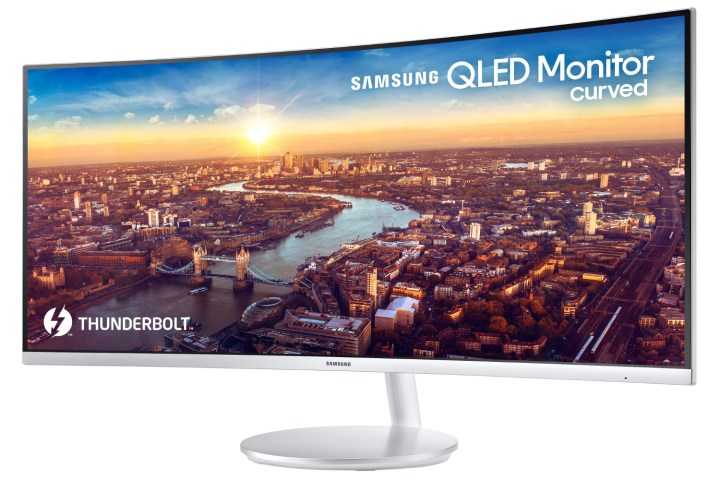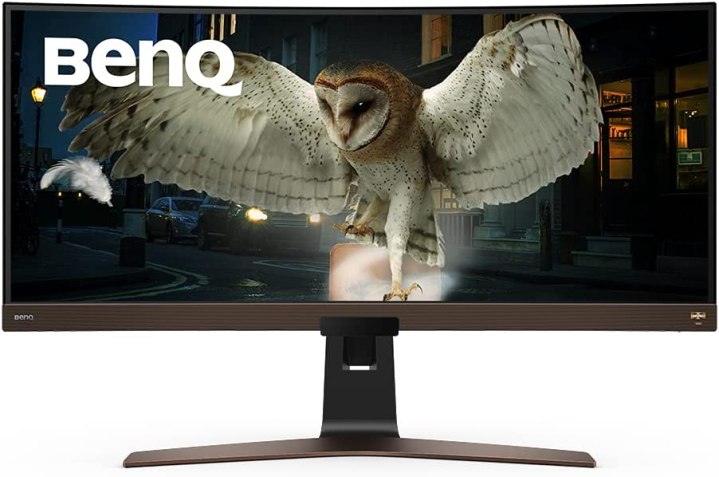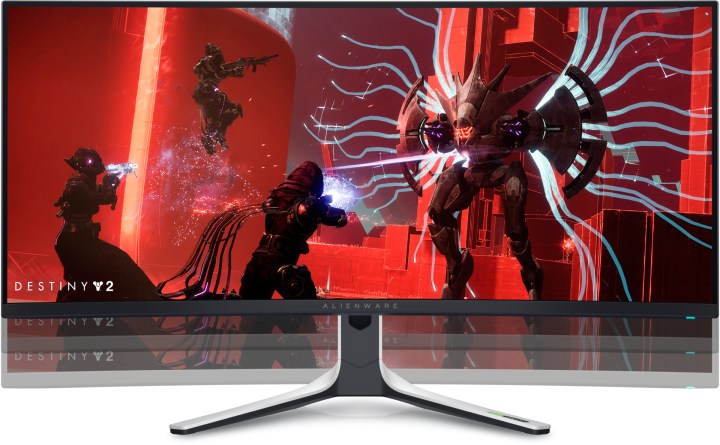If you’re looking for a new desktop experience, upgrading your setup with an ultrawide monitor can deliver more immersive gaming, especially curved models. Plus, these monitors offer extra space, so they’re great for multitasking at work and more.
There are some important considerations when it comes to size, resolution, and syncing capabilities with your graphics card when choosing a new monitor. Our guide to the best ultrawide monitors will give you a better idea of the features of the best products available on the market. Let’s take a look at our top picks, starting with the well-rounded Samsung CJ791.

Samsung CJ791 Ultrawide Curved Gaming Monitor
Best well-rounded ultrawide
Pros
- Excellent 34-inch design
- FreeSync support
- Great picture quality
Why you should buy this: It’s one of the best examples of how useful an ultrawide can be.
Who’s it for: Anyone who wants an ultrawide for work or play.
Why we picked the Samsung CJ791:
This 34-inch monitor is a striking piece of hardware. The design is understated, effortless, and professional. The frame and stand all seem to melt away when you’re seated before its all-encompassing curved view. It’s a bit of a chameleon, too, as it could easily sit next to a flashy desktop PC decked out in LEDs or a dusty old workstation in the office. It even works with VESA mounts, if you want to mount it to a wall.
Samsung’s CJ791 offers stunning picture quality, with rich inky blacks and vivid, lifelike colors saturating your vision from all angles. Video content is rich and fluid, thanks to the monitor’s 100Hz refresh rate and AMD’s FreeSync. It supports a variety of uses, providing one DisplayPort, an HDMI port, two Thunderbolt 3 ports, and two USB-A ports.
Overall, this level of quality on a standard 16:9 display would be outstanding. The fact that it’s on a massive 21:9 display with a deep curve makes it truly a sight to behold. The Samsung CJ791 simply doesn’t need a flashy exterior design. Its size, clarity, and resolution make it a showstopper all on its own.

Samsung CJ791 Ultrawide Curved Gaming Monitor
Best well-rounded ultrawide

Alienware AW3420DW
The best game-friendly ultrawide
Pros
- 120Hz native refresh rate
- Curved panel for gaming
- Easy manual preset modes
- G-Sync support
Cons
- May be too small for some ambitious gamers
Why you should buy this: It’s an ultrawide built for gaming with great results.
Who’s it for: Gamers who play games that support larger aspect ratios.
Why we picked the Alienware AW3420DW:
Dell’s 34-inch Alienware ultrawide monitor is an excellent gaming monitor as it has everything a gamer might want to handle. It packs a 3440 x 1440 resolution complemented by a curved IPS panel (1900R), producing rich colors and wide viewing angles. Complementing this panel is a 350-nit brightness maximum and a 1,000:1 contrast ratio. This makes your images look great.
The AW3420DW includes six physical menu buttons for toggling preset modes, automatic overclocking, dark stabilization, and controlling brightness and contrast. Tucked away below the display’s bottom edge, you’ll find a line-out jack, a headphone jack, five USB ports, DisplayPort 1.2 input, and HDMI 1.4 input.
In keeping with Alienware tradition, adjustable LED strips line the angular spines on the backside and stand. Gamers will also see the popular alien head logo shining on the back. The screen’s black bezels are minimal at best, while the back sports a gunmetal titanium finish.
Finally, the Alienware AW3420DW features Nvidia’s G-Sync technology for smooth, tear-free frame rates. It also has a native 120Hz refresh rate and a two-millisecond response time. It’s a slight step up from the previous model, the Alienware AW3418DW, which packs a lower native 100Hz refresh rate and a slower 4ms response time for $100 less.

Alienware AW3420DW
The best game-friendly ultrawide

LG 34WK95U-W
Best high-res ultrawide
Pros
- Attractive, minimalist design
- Convenient port location
- Easy-to-use menus
- Class-leading image quality
- My god, it’s full of pixels
Cons
- Far more expensive than competitors
- No enhanced refresh rate or adaptive sync
- Warranty should be longer
Why you should buy this: It’s an extra-high resolution ultrawide ready for the details.
Who’s it for: Editors, photographers, and those using their ultrawide for high-end media.
Why we picked the LG 34WK95U-W:
If you need an ultrawide panel without sacrificing a high resolution, this LG model offers both — that is, if you can afford it. A Nano IPS panel backs this display’s hefty 5120 x 2160 resolution with HDR. It’s also entirely flat, making it a wide choice when considering your work area’s physical space (or lack thereof).
You won’t need to worry about connections, however. There are plenty on LG’s display, including a Thunderbolt 3 port, a USB-C port, two HDMI, a DisplayPort, a USB-A upstream, and two USB-A downstream connections.
The drawback is that wall-mounting isn’t advisable, as this could leave the ports inaccessible. Wall-mounting may also make the hidden joystick difficult to use, which means you’ll need to modify the settings. With this joystick, you can toggle picture modes, manually adjust color temperature, and change the hue and saturation.
Our tests show that, in addition to the high resolution, the LG 34WK95U-W supports 90% of the AdobeRGB color gamut. It also has a color error of only 1.1 and a gamma curve of 2.2 — all better than many of the top monitors we have reviewed. However, it’s important to note that the standard refresh rate is 60Hz, which isn’t the greatest option for some types of gaming. This display does not offer FreeSync or G-Sync technology.

LG 34WK95U-W
Best high-res ultrawide

Acer Predator Gaming X34
The best mid-range gaming ultrawide
Pros
- A solid gaming ultrawide without sky-high prices
- Can overclock to 180Hz
- G-Sync support
Cons
- Not the largest curved screen available
Why you should buy this: Gamers searching for a mid-to-high-range curved monitor will find just what they’re looking for.
Who’s it for: Gamers who want a curved ultrawide dedicated to gaming.
Why we picked the Acer Predator Gaming X34:
This Predator monitor is an excellent mid-range option for a curved ultrawide designed for gaming, great for gamers that don’t want to spend anything over $1,000 but still want a 34-inch monitor that can handle anything they want to throw at it. It comes with a QHD 3440 x 1440 resolution, G-Sync support, and up to a 180Hz refresh rate. Color is also a standout with 98% coverage of the DCI-P3 cinematic gamut.
Thanks to its IPS panel, Acer’s display enjoys fantastic viewing angles for collaborative work and play. There’s also DisplayHDR 400 support, and eight different gaming modes you can experiment with to find the right options. Ports include a wealth of options like DisplayPort 1.4, HDMI 2.0, USB-C, and USB-A 3.0. I

Acer Predator Gaming X34
The best mid-range gaming ultrawide

BenQ Premium EW3880R
Best ultrawide for creatives
Pros
- HDR and HDRi with ambient light sensor
- Great color accuracy
- Built-in speakers and subwoofer
- USB-C with PD
Cons
- Not all creatives will want a monitor this big
Why you should buy this: It’s an excellent professional monitor with great color specs.
Who’s it for: Creatives, video editors, designers, etc.
Why we picked the BenQ Premium EW3880R:
BenQ’s monitors typically perform very well in our color tests, and this extra-large 38-inch ultrawide won’t disappoint creative professionals who need lots of screen space. This model covers 95% of the DCI-P3 space, plus BenQ’s latest HDRi optimization, a proprietary form of HDR designed to improve images from all kinds of sources while tracking ambient light in the room. It also supports more traditional formats like HDR10, and that light sensor can automatically adjust brightness as well as color temperature for the best combined results.
This monitor is also ready for newer accessories including USB-C with PD as well as HDMI 2.0, DisplayPort 1.4, and USB 3.0. For those who do a lot of comparisons, the picture-by-picture and similar modes will also be of great help. Oh, and if you want to show off a particular clip with sound, the built-in 3W speakers and 8W subwoofer will help you save on speaker space; you’ll need a lot of it for a monitor this size.

BenQ Premium EW3880R
Best ultrawide for creatives

AOC CU34G2X
Best budget ultrawide
Pros
- Great features for the price
- 144Hz refresh rate
- Great color accuracy
- Adaptive-Sync support
Cons
- Lacks higher resolution and extra features
Why you should buy this: It’s a more affordable ultrawide that doesn’t disappoint.
Who’s it for: Anyone who wants to save while getting a higher refresh rate.
Why we picked the AOC CU34G2X:
If you’re interested in some of the benefits of an ultrawide, like extra screen space for multitasking, but you prefer saving money compared to more expensive models, this AOC monitor clocks in at a more affordable price. The 34-inch curved QHD display is still an excellent choice, and you still get gaming-friendly specs including a 144Hz refresh rate that supports Adaptive-Sync and a 1ms response time.
The AOC CU34G2X also has a strong color range, spanning 98% of the AdobeRGB gamut, so it’s a potential model for creators and editors as well. Ports are numerous, including two DisplayPort 1.4, two HDMI 2.1, and four USB 3.2 connections. There are also a few handy native modes here like reducing flicker and blue light to help with eye strain. Overall, it’s a good pick for saving money without giving up too many benefits of an ultrawide.

AOC CU34G2X
Best budget ultrawide

Samsung Odyssey Neo G95NA
The best extra-large ultradwide
Pros
- Enormous 49-inch screen
- G-Sync and FreeSync support
- 240Hz refresh rate
Cons
- Too big for many desks
- Expensive
**Why you should buy this: **It’s one of the biggest consumer ultrawides you can get.
**Who’s it for: **Buyers who have a whole lot of space and big ultrawide plans.
Why we picked the Samsung Odyssey Neo G95NA:
If you prefer a lot of “ultra” in your ultrawide, Samsung’s impressive Odyssey model offers an immense 49 inches of screen real estate, enough for anyone’s plans. It’s a monitor made for niche setups that have plenty of desk space and need a particularly huge display, such as a full racing station setup or some seriously in-depth video editing, etc.
The monitor also has up-to-date specs, including a UHD resolution Mini-LED panel for improved backlighting and extensive peak brightness, up to a 240Hz refresh rate, and a 1ms response time, making it suitable for any demanding task or game you have in mind. It’s also one of the only monitors on our list to support both G-Sync and FreeSync, so you don’t have to worry about what graphics card you have. However, you may have to worry about your wallet, because this giant monitor doesn’t come cheap.

Samsung Odyssey Neo G95NA
The best extra-large ultradwide

Alienware AW3423DW
Best ultrawide for visuals
Pros
- QD-OLED panel technology
- 175Hz refresh rate
- VESA Display HDR True Black 400
- UHD resolution
- G-Sync Ultimate
Why you should buy this: A top-notch monitor with excellent visual specs.
Who’s it for: Users interested in optimization for a variety of media.
Why we picked the Alienware AW3423DW:
This Alienware monitor claims to be the first consumer QD-OLED model, and it’s certainly the best place to go for incredibly vivid color and contrast. The 34-inch display offers a UHD 3440 x 1400 resolution, 175Hz refresh rate, and compatibility with G-Sync Ultimate, making it suitable for all kinds of entertainment options. It also covers 99.3% of the DCI-P3 color gamut, respectable numbers for those who want a cinematic movie experience on their ultrawide.
The model also supports VESA Display HDR True Black 400 for enhanced visuals (helped by a 1000-nit peak brightness), and sports an impressive 0.1ms response time. Ports include HDMI 2.0, DisplayPort 1.4, and USB 5-compatible USB ports.
While expensive, this Alienware pick is on the cutting edge of panel technology, and one of the best current picks if you’re willing to spend money for your visuals.

Alienware AW3423DW
Best ultrawide for visuals
Frequently Asked Questions
Is an ultrawide monitor worth it?
Ultrawide displays are an alternative to multiple-monitor setups. They eliminate the ugly bezel dividing two or more displays, creating a cleaner, unified experience.
With multiple monitors, you can mix and match capabilities. For instance, you can have one for gaming and one for work. In both cases, the setup makes getting everything you need easier.
With an ultrawide, everything must reside in one display, or you need to make some sacrifices. That’s especially impactful in gaming, where an ultrawide’s large resolution can tax even high-end graphics cards.
You should also factor in the physical footprint of large ultrawide displays. They can be huge, so make sure your desk and room have enough space to accommodate the size.
Also consider media playback, such as TV and movies. On an ultrawide, you may have to tolerate black bars running along the screen’s edges, as few productions shoot media that’s compatible with ultrawide aspect ratios.
Is an ultrawide monitor good for gaming?
It can be. Although not all ultrawide displays are designed with gaming in mind, the ones that are can offer some of the most immersive gaming experiences outside of virtual reality. Curved, large-screen, ultrawide monitors can wrap around your peripheral vision in a way that’s far more encompassing than traditionally-sized monitors.
Just be aware that not all games support ultrawide resolutions, and those extra pixels can tax your graphics card a bit more than normal.
How to split the screen on an ultrawide monitor?
How you portion out your screen is entirely your choice, but you can snap multiple windows or applications into place with ease in any recent version of Windows. Click and drag the window to any edge of the screen, and release it to have it snap into place. Another way to do this is by pressing the Windows key and any arrow key to lock the window to that part of the screen.
From there, you have the option to fill the extra space with other windows. If you want, you can manually lock them as well, just use the same method as above. Once everything’s in place, you can click and drag the dividing lines between windows to adjust their size.
Some ultrawide monitors offer more powerful hardware solutions, however, they can vary depending on each manufacturer. Check your setup manual for the specifics.
What size of ultrawide monitor is best?
There’s no right answer to this question. No single monitor size is “one size fits all.” It’s a subjective decision that varies from one person, and work area, to the next. To decide what will be best for you and your personal situation, you’ll need to consider your particular application, in addition to the space you have to use. If you’re wondering, the largest ultrawide monitors are 49-inch screens, like Samsung’s CHG90 or Dell’s 49-inch Ultrasharp display.
We’re already aware that monitors less than 49 inches usually have better pixel density, an important factor that influences your total picture clarity. While it can be fun to daydream about having a huge screen, in reality, it’s not really necessary to have the biggest screen on the market to get the full effect of movies or games. You simply need the right proportions.
The 34-inch options with a 21:9 aspect ratio are a good starting place. You’ll enjoy the full ultrawide experience and it won’t be so whopping huge that you no longer have any desk space left to work.
Why does my ultrawide show black bars?
Not all content will automatically adapt to the ultrawide aspect ratio. There is one fix you should always try: On your PC, head to Appearance and Personalization, then go to Advanced Settings, then Graphics Control. Here you will find a Scaling option where you should be able to Customize Aspect Ratio. The standardized aspect ratio for ultrawides is 21:9. You may have to look at your GPU settings to find out more about individual issues.
Is a single ultrawide or two connected monitors better?
Two connected monitors are generally better for common multitasking (although screen modes in ultrawides can also help), while an ultrawide is better for immersive entertainment. Your own preference will also have a big impact.
How do I get wallpapers for an ultrawide?
Search for wallpaper specifically designed for an ultrawide or a widescreen. They aren’t as common, but they’re out there. There’s even a subreddit devoted to it!
Editors’ Recommendations




